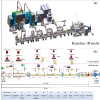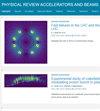X 波段恒定梯度结构的设计与测试
IF 1.8
3区 物理与天体物理
Q3 PHYSICS, NUCLEAR
Physical Review Accelerators and Beams
Pub Date : 2024-09-06
DOI:10.1103/physrevaccelbeams.27.090401
引用次数: 0
摘要
清华大学正在开发一个名为 "非常紧凑反康普顿散射伽马射线源"(VIGAS)的光源项目。VIGAS的目标是在12米长的光束线内,通过350兆电子伏特电子束与400纳米激光光子的碰撞,产生单色高能伽马射线。为了在如此紧凑的空间内产生高能电子束,该系统由一个S波段高亮度注入器和六个X波段高梯度加速结构组成。X 波段结构的目标是在 80 MV/m 的高梯度下运行。因此,我们采用了恒定梯度行波方法,即从第一个单元到末端单元的光圈是锥形的。该结构有 72 个单元,包括 70 个单元和 2 个耦合器,因此我们将其命名为 XT72。XT72 的频率选为 11.424 GHz,采用 2π/3 模式。本文对第一款 XT72 的详细设计、制造、射频调谐和大功率测试结果进行了全面研究。此外,我们还将该结构的性能与之前的恒定阻抗结构进行了比较。我们的研究结果表明,XT72 能够以较低的击穿率在 80-MV/m 梯度下工作。这一进步为 VIGAS 项目的发展铺平了道路,并有助于在紧凑型加速器设施中更广泛地应用 X 波段室温高梯度结构。本文章由计算机程序翻译,如有差异,请以英文原文为准。

Design and test of an X-band constant gradient structure
A light source project named very compact inverse Compton scattering gamma-ray source (VIGAS) is under development at Tsinghua University. VIGAS aims to generate monochromatic high-energy gamma rays by colliding 350-MeV electron beams with 400-nm laser photons within a 12-m beamline. To produce a high-energy electron beam in such a compact space, the system consists of an S-band high-brightness injector and six X-band high-gradient accelerating structures. The goal of the X-band structure is to operate at a high gradient of . Therefore, we adopts the constant gradient traveling wave approach, where the iris from the first cell to the end cell is tapered. The structure has 72 cells, including 70 cells and 2 couplers, so we named it XT72. The frequency of XT72 is selected to 11.424 GHz, and the mode is adopted. In this paper, we present a comprehensive study covering the detailed design, fabrication, rf tuning, and high-power test results of the first XT72. Additionally, we compare the performance of this structure to that of the previous constant impedance structure. Our results demonstrate that the XT72 is capable of operating at an gradient with a lower breakdown rate. This advancement paves the way for the development of VIGAS project and contributes to the wider application of X-band room-temperature high-gradient structures in compact accelerator facilities.
求助全文
通过发布文献求助,成功后即可免费获取论文全文。
去求助
来源期刊

Physical Review Accelerators and Beams
Physics and Astronomy-Surfaces and Interfaces
CiteScore
3.90
自引率
23.50%
发文量
158
审稿时长
23 weeks
期刊介绍:
Physical Review Special Topics - Accelerators and Beams (PRST-AB) is a peer-reviewed, purely electronic journal, distributed without charge to readers and funded by sponsors from national and international laboratories and other partners. The articles are published by the American Physical Society under the terms of the Creative Commons Attribution 3.0 License.
It covers the full range of accelerator science and technology; subsystem and component technologies; beam dynamics; accelerator applications; and design, operation, and improvement of accelerators used in science and industry. This includes accelerators for high-energy and nuclear physics, synchrotron-radiation production, spallation neutron sources, medical therapy, and intense-beam applications.
 求助内容:
求助内容: 应助结果提醒方式:
应助结果提醒方式:


